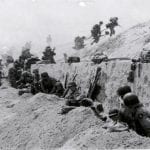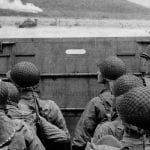The following article about Kristallnacht is an excerpt from Richard Weikart’s book Hitler’s Religion: The Twisted Beliefs that Drove the Third Reich. It is available to order now at Amazon and Barnes & Noble.
The Crystal Night (Kristallnacht) pogrom against the Jews on November 9–10, 1938 was an attack against Germany’s Jewish population carried out by SA paramilitary forces and German civilians. Authorities did not intervene. Jewish-owned stores, buildings, and synagogues were smashed, resulting in shards of broken glass littering the streets.
Roots of Kristallnacht

Kristallnacht
The manifestation of this religiously-bigoted attack are simple, but its reasons are more complex. At first glance Kristallnacht appears to be a blatant form of religious persecution, since that night Nazi ruffians torched multitudes of synagogues and deliberately burned Hebrew Bibles. Dozens of Jews were murdered and thousands were arrested, though most were released within a few weeks with instructions to emigrate. Given Hitler’s own contempt for the Hebrew Bible, this burning of the Jewish scriptures should come as no surprise. Indeed, those who construe Kristallnacht as an act of Christian religious persecution against Jews are the ones who should be surprised that the Nazis purposely targeted the Jewish holy books and scrolls, because the Hebrew Bible is the Christian Old Testament. In essence, the Nazis were destroying an integral part of the Christian Bible.
The historian Alon Confino recently drew attention to this Bible burning in Nazi Germany in an interesting and provocative essay, but his main argument is puzzling: “There is nothing in racial ideology itself that can explain the symbolic meaning of destroying synagogues and the Bible.” Confino, like some of his peers, is subjecting the “racial state” paradigm to critique, attempting to show that even though racial ideology was important, it has “diminished explanatory value.” However, later in his essay Confino correctly explains the way that biological determinism shaped the Nazi understanding of culture: “Biology constructed for Germans a moral category of right and wrong because, they believed, of the way it determined their spirit— or, to use current terminology, their culture.” In my view, this explains how the burning of Jewish scriptures and synagogues during Kristallnacht meshes with Nazi racial ideology.
Hitler—and most other Nazis—saw the Jewish religion and other elements of Jewish life as a manifestation of their mental and moral characteristics, which, he believed, were biologically innate. Further, their religion was an expression of their immoral character and served them in their struggle against other races. Thus, in Mein Kampf, Hitler claimed that “the Mosaic religion is nothing other than a doctrine for the preservation of the Jewish race,” and served as an “ingenious trick” to gain toleration.
Confino is right to note that burning Bibles aimed at a cultural, not a racial, target. However, for Hitler, race and culture were intertwined, with culture being an expression of racial character. We should also remember that not only synagogues, but Jewish shops, schools, and orphanages were vandalized on Kristallnacht, so Nazis were not singling out Jewish religious places or items for persecution. Anything Jewish was subject to attack.
Kristallnacht: A Christian Attack?
Confino, however, expands his argument about the religious nature of Nazi anti-Semitism in his book, A World Without Jews: The Nazi Imagination from Persecution to Genocide. Therein, Confino argues for “an intimate link between Nazism and Christianity.” He explains that Nazis considered it vital to eliminate the Jewish religion, because “by persecuting and exterminating the Jews, the Nazis eliminated the shackles of a past tradition and its morality, thus making it possible to liberate their imagination, to open up new emotional, historical, and moral horizons that enabled them to imagine and to create their empire of death.” This last statement has merit, but there is no reason to think, as Confino does, that the Nazi eradication of Jewish culture and religion in such events as Kristallnacht is somehow inconsistent with biological racism. Again, Hitler considered Jewish history and heritage—including Jewish religion and morality—a manifestation of their innate biological properties.
Less than three months after Kristallnacht, in his infamous speech on January 30, 1939, Hitler ominously warned the Jews, “Once again I will be a prophet: should the international Jewry of finance succeed, both within and beyond Europe, in plunging mankind into yet another world war, then the result will not be a Bolshevization of the earth and the victory of Jewry, but the annihilation of the Jewish race in Europe.” Hitler was already preparing for a war in the east, and he wanted the western democracies, which he thought were under the influence of Jews, to stay out of it. In this speech, Hitler portrayed the Jews as a race intent on destroying Germany through economic power and Bolshevism, as indicated in this “prophecy.” Hitler was intent on persecuting the Jews because of their racial character, which manifested in economic exploitation and political domination, not because of their religious convictions.
This post is part of our collection of resources on Nazi Germany. Click here for our comprehensive information resource on the society, ideology, and key events in Nazi Germany.
 |
This article is an excerpt from Richard Weikart’s book Hitler’s Religion: The Twisted Beliefs that Drove the Third Reich. It is available to order now at Amazon and Barnes & Noble.
You can also buy the book by clicking on the buttons to the left.
Cite This Article
"The Anti-Semitic, Darwinian Roots of Kristallnacht" History on the Net© 2000-2024, Salem Media.
July 27, 2024 <https://www.historyonthenet.com/kristallnacht-anti-semitic-darwinian-roots>
More Citation Information.











